Ex-military nurse now fights for vets
January 31, 2013
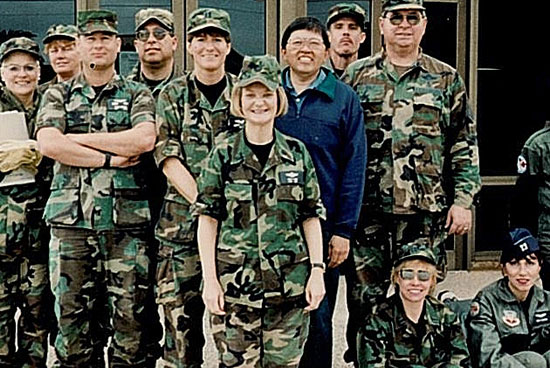
Ruth Wong, center, leading a military exercise at Camp Pendleton in 1990, a year before Operation Desert Storm.
Even as a little girl, Ruth Wong aspired to the Right Stuff.
“I knew at 8 years old that I wanted to be a nurse, and I was probably 12 when I started thinking about the military,” she remembers.
By the age of 20, she was in the U.S. Air Force, studying to become a flight nurse. By 40, she was in the Persian Gulf, commanding 50 medical personnel, sleeping in a chemical suit and packing a 9-millimeter sidearm.
By the time she retired from the service in 2001 and went to work for Los Angeles County, she was a Brigadier General.
So last week, as U.S. Defense Secretary Leon Panetta lifted the ban on women in combat, Wong—who last month became the first woman to head the Los Angeles County Department of Military and Veteran’s Affairs—cheered it as a step in the right direction for the institution that had helped her realize her heart’s desires.
“They’ll have to be physically able, emotionally strong, and be able to fight shoulder-to-shoulder with their male counterparts,” she says. “But this is going to afford an opportunity for women to advance in career fields they may have dreamed about for a very long time.”
Wong, who moved to the military and veterans affairs department in August after nearly a decade as executive director of the county’s Quality and Productivity Commission, says she sometimes thinks that her whole life has been leading her toward her current job.
“When I came here, I was told it would be a temporary assignment,” says Wong, who became acting director after the retirement of Col. Joseph N. Smith in December. “But after a couple of months, I began to think, ‘This is where I belong.’”
The department, which helps L.A. County veterans access housing, education, mental health care and other services, offers a front-line view of the military’s evolution and of veterans’ evolving needs. A 2010 study by the Economic Round Table counted 328,000 veterans in Los Angeles County, including some 36,000 who had served since 9/11. That total, Wong says, has since grown to an estimated 400,000, and is projected to grow further by 2017 as forces in Afghanistan and Iraq complete planned drawdowns.
“About a third of the young people coming back from Iraq and Afghanistan are suffering from post-traumatic stress or some other mental health issue,” Wong says. “Those who aren’t suffering from post-traumatic stress are having to adapt to a new environment.”
And, Wong says, the new veterans are twice as likely to be female; 13% of veterans returning from Iraq and Afghanistan are women, compared to 6% of veterans overall, according to the Economic Round Table. The ban on women in combat notwithstanding, she says, the female veterans now have seen more action than at any time in U.S. history, and are coming home with not only that trauma, but with a whole set of needs specific to women.
“Some are coming back as primary caretakers to families and children, or maybe to a husband they have to bond with again,” she says. “We are seeing women who, unfortunately, are getting divorced, with young children, and have no job and don’t know where to go.”
Wong understands these struggles, both as a married woman and as a veteran who has watched the military evolve since the early 1970s. When she WAS commissioned as an Air Force officer, fresh out of nursing school in Chicago, the Vietnam War and the draft were winding down and the Equal Rights Amendment was being debated. Women made up less than 2% of the armed forces and were barred from two-thirds of the military job specialties.
“I wasn’t a feminist,” she says, recalling that her main motivation had been to travel without having to postpone her career in nursing. In fact, when her World War II-veteran father feared aloud for her safety, “my response was, ‘I’m going to be a nurse in a hospital—I probably won’t even carry a gun.’”
She met her husband, a Pasadena physician, while they were both stationed at a New Mexico air base. She served at Point Hueneme while he built a Southern California practice. Then, in 1991, war struck. Wong was promoted to flight commander of Aeromedical Evacuation Operations at the Sharjah Air Base in the United Arab Emirates. Though Operations Desert Storm and Desert Shield never brought her directly into combat, she says, she was responsible for scores of subordinates and there were frequent threats of chemical attack from SCUD missiles.
The experience shaped her in ways she recognizes in the veterans she serves now.
“I was stronger when I came back,” she says. “Just being in a country that was so different, in a wartime scenario, working with people I’d never worked with before—just being able to survive all that gave me a feeling of, ‘I can do almost anything. I’m a little bit more of a superwoman than I thought I was.”
It also sensitized her to veterans’ struggles. “They’ve faced so many things that others haven’t had to experience or face,” she says. “Things in their hometowns are different. They’re different. When I came back from the Persian Gulf, I was different.”
And, she says, so were her loved ones. “My husband is a jovial person, and when I came back, people told me over and over, ‘Your husband didn’t smile the whole time you were gone.’”
The 6-month deployment moved Wong up the ladder; her final decade in the military was spent directing and administering nursing services for the Air Force at Andrews AFB and in the Surgeon General’s Office in Washington, D.C.
She retired just before 9/11 and returned fulltime to Pasadena, where she and her husband had based their temporarily bicoastal marriage. Then the military changed her life again.
This time, it was a phone call from an old Air Force buddy, wondering if she would be interested in an opening at Los Angeles County, where the friend now worked. Soon, Wong, who had spent six years consulting with nurses to make Air Force field units more efficient, was evaluating efficiency at the county Department of Mental Health.
That gig led to the job as executive director at the Quality and Productivity Commission, and, in turn, to her current job—proving, she says, that with or without combat experience, military service can be valuable in the civilian workplace.
As can Air Force buddies. “As they say, 66% percent of all jobs are gotten through networking,” she says with a laugh.
Posted 1/31/13
A new Rx for our shelter pets
January 31, 2013

These lucky dogs were adopted from L.A. County shelters, where hopes are high because of a new grant.
An injured eye shouldn’t be a death sentence. And yet, such minor medical problems often lead to euthanasia for dogs and cats in animal shelters.
Dr. Maria Sabio-Solacito has been treating animals for 20 years, five of them as head veterinarian for Los Angeles County’s Department of Animal Care and Control. She says she’s seen far too many animals put down when some basic medical treatment could have made them more adoptable.
“Before, the idea was just to grab all the stray dogs and, if no one takes them, euthanize,” said Sabio-Solacito. “Now, we are much more focused on animal care.”
Giving that effort a big boost, the Board of Supervisors on Tuesday approved a $50,000 grant to enhance medical-care capabilities at the county’s six regional shelters, or “animal care centers.”
Limited resources have been the primary challenge for the county’s shelter system, the nation’s largest. Each year, the county is forced to euthanize thousands of cats and dogs. Between July 2011 and June 2012, the agency killed 24,605 cats and 17,745 dogs. (But it also was successful in getting 7,387 cats and 26,942 dogs into adoptive homes or reunited with owners during that period.)
The grant was given to the L.A. County Animal Care Foundation by the American Society for the Prevention of Cruelty to Animals. The foundation is a nonprofit organization that raises funds for the Department of Animal Care and Control and supports spay and neuter programs, pet adoptions, public education and other animal welfare activities in the region.
With the money, the county will purchase eye surgery, dental and blood-testing equipment—resources Sabio-Solacito and her colleagues identified as the most needed and most likely to make the biggest impact. The agency currently contracts with local clinics for those services, an expensive practice that limits how many animals it can treat.
The equipment will enable staff to perform minor surgeries, dental cleanings and offer other vital treatments to sick and injured animals. Eye and dental conditions are highly common in shelters and can lead to serious secondary infections. Shelter officials are optimistic that the new medical services will lead to more adoptions and fewer deaths.
“A lot of animals don’t get adopted just because they have bad teeth,” said Sabio-Solacito. “It’s just because they have been neglected.”
Appearances matter for pups and felines seeking new homes, said Evelina Villa, spokesperson for the county agency. Potential owners shy away from pets with unattractive problems that could require treatment.
“The breath is a big thing too,” she laughed.
For more serious injuries, the Animal Care Foundation funds a program called “Dreams Come True.” Using donations and reduced-rate services from local veterinary schools, even some of the toughest cases of injury or abuse can be treated.
“A huge portion of the animals that come into the shelter were hit by cars,” said Sabio-Solacito. “We used to euthanize. Now we can do surgery or amputations.”
Sabio-Solacito hopes to someday obtain enough funding for a full-service animal medical center, which she’d call “The Second Chance Hospital.” For now, however, she says she’s thrilled with the improvements that are on the way.
“Every little bit of help that we get to properly diagnose and treat conditions makes a huge impact.”
Posted 1/31/13
Fixes on TAP at Metro
January 30, 2013
You griped, they listened.
As Metro prepares to finally latch its subway gates this summer, the agency’s transition from paper tickets to the mandatory plastic TAP cards needed to make the new system work has been rocky at times.
New or occasional users complained that they couldn’t decipher the jargon and complicated instructions displayed on vending machine screens. Senior citizens said it was impossible to figure out how to buy a reduced-fare ride. And transferring passengers protested inconvenient detours that, in some cases, force them to go long distances to tap their cards before returning to the train platform and continuing their trip.
But help is on the way. Metro is overhauling the signage around its vending machines in an effort to make the process clearer and also has tweaked the on-screen instructions for people trying to buy a ticket. Behind the scenes, a broader do-over of the computer screens is underway, with a series of focus groups offering input on how to create a truly user-friendly process.
In addition, the agency is relocating “stand-alone validators”—which customers must touch with their TAP cards to legally board the train—at 24 stations. Those include the Wilshire/Vermont station, where passengers transferring between the Red and Purple lines must hop on an escalator or hike up and down 200-plus steps if they want to play by the rules and tap their cards before boarding.
“That was ridiculous. That was just not acceptable,” said David Sutton, Metro’s director of TAP operations. He said the sheriff’s department isn’t citing people in problematic areas—places where a customer has to “leave a rail platform, go upstairs, tap, come back down” in order to fulfill the law.
The Los Angeles County Sheriff’s Department is issuing plenty of other citations, though—69,839 of them between February, 2012 and the end of December, 94% of them for fare-evasion.
The transition toward locked turnstiles marks a major turning point for Metro riders in Los Angeles, who, unlike passengers in cities like New York or San Francisco, have until now traveled effectively on the honor system.
There is some debate over how much additional revenue locked gates will generate. (In 2008, when the agency’s board approved installation of a $46 million barrier gate system, it was estimated that fare-beaters cost the system $5.5 million a year, and that the system would eventually pay for itself.)
But there’s no question that the march to locked turnstiles has been challenging and complex. In addition to issues with confusing vending machines and poorly located validators, the agency also has had to grapple with how to make Metro’s new system work for thousands of regional commuters on Metrolink, which uses paper tickets.
A paper ticket with an embedded smart chip has been developed for Metrolink passengers, and on the fourth floor of Metro’s Gateway Headquarters this week, employees in the agency’s ticketing lab were busily testing prototype tickets to make sure they worked like a TAP card to open the gates. Broader field testing is planned in the weeks ahead.
The rush of activity is intended to meet a June deadline for beginning to lock the gates on the Red and Purple lines. (That work is expected to wrap up by the end of August. After that, latched turnstiles will be coming to the Green Line and portions of the Blue and Gold lines.)
With that in mind, Sutton and his staff also are scrambling to complete work on the revamped computer screen design by June. Up to $250,000 has been allotted for the project, which includes six to eight focus groups and a series of community meetings.
“We want to ask people who’ve never used our equipment: ‘Can you make a purchase? Try it.’ And if they can, it’s thumbs up. If they can’t, then we need to find out where the problem happened,” Sutton said. “We want them to just go up to the machine and do it.”
Two focus groups held so far—one in English, one in Spanish—“gave us a lot of good input about what they wanted,” Sutton said. “They wanted this A-B thing: ‘If I have a TAP card, I want a shortcut. If I don’t have a TAP card, I want you to tell me that I need a TAP card and why.’ ”
Sutton said that focus groups weren’t consulted originally as the agency hastened to accomplish the transition from paper to plastic.
Getting a second chance to hear from the public now is invaluable.
“We have this golden moment that we can actually step in and right any wrongs and make it a better system. Not many government agencies really have this opportunity to get things straightened out,” Sutton said. “Did it work before? Absolutely. We’ve got 20 million taps a month. So you know something’s going right…But we have a great opportunity at this point to look at it differently, to step out and reconsider, and I think that’s what we’re doing right now.”
Beyond the multifaceted efforts to revamp and improve, with more than 2 million TAP cards now in circulation and all of the region’s municipal bus operators now onboard, there’s evidence that the public is getting more comfortable with the system.
“We don’t get as many complaints anymore,” Sutton said. “I’m not getting any love letters, but we’re doing all right.”

Sutton and his team are going back to the drawing board to create more intuitive vending machine screens.
Posted 1/30/12
What’s up at the Bowl?
January 30, 2013

The rabbit's animated but the orchestra's real in "Bugs Bunny at the Symphony II" at the Hollywood Bowl.
Ladies and gentlemen: start your picnic planning. From Bugs Bunny to Tchaikovsky, the upcoming summer season at the Hollywood Bowl promises a multi-course feast for every musical appetite.
Featured artists include the L.A. Philharmonic’s maestro Gustavo Dudamel, who’ll be conducting the orchestra and soloists in Verdi’s Aida and Requiem.
Other superstars on the roster include Tony Bennett, Natalie Cole, Willie Nelson and Itzhak Perlman. Yo-Yo Ma plays against type as part of Goat Rodeo.
Josh Groban is headlining a series of July 4th Fireworks Spectaculars, while She & Him, Pink Martini, Blue Man Group and Steve Martin and the Steep Canyon Rangers will be making appearances this summer as well. Also on tap: Kristen Chenoweth, Queen Latifah and ABBA Fest, featuring the tribute band Waterloo.
This year’s musical is Chicago. And everyone, regardless of vocal ability, can get in on the act at the Grease and Sound of Music sing-alongs (costumes optional.)
New and renewed subscriptions are available now. Tickets for five events or more go on sale March 19, with single ticket sales beginning in early May. Check out the 2013 schedule here and start planning your summer Bowl excursions. After all, in the words of the great Bugs Bunny himself, “the acoustics are poifect.”
Posted 1/30/13
Understanding gun violence
January 25, 2013
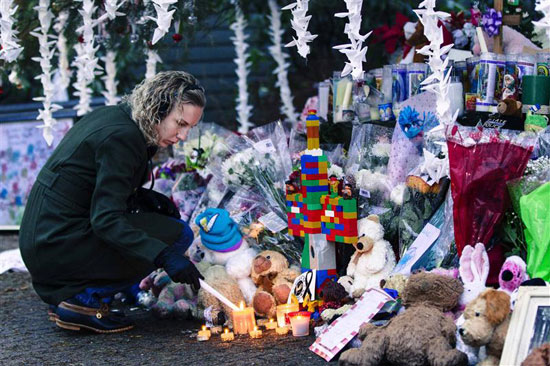
The Newtown elementary school shootings have pushed mental health issues to the forefront of the gun debate.
Dr. Marvin J. Southard is of two minds when it comes to the current debate over gun violence and the mentally ill.
The director of Los Angeles County’s Department of Mental Health, the nation’s largest, welcomes the renewed awareness of the need for programs and treatment. But he worries that, because mass shootings such as those at Newtown, Conn.—and Aurora, Colo., and Tucson, Az.—were all committed by young men in the throes of apparent breakdowns, the connection fuels the false impression that the mentally ill among us are more violent than the rest of the population.
“Gun violence is more connected with the availability of guns than it is with mental illness,” says Southard.
“I applaud the attention to the need for additional resources for mental health treatment, but some of the connections between mental health and gun violence are tenuous. The mentally ill are no more likely to be violent than the man on the street.”
Southard has been among those who have sought to provide context since the December massacre at Sandy Hook Elementary School, which claimed 26 lives. Although gun control has been advanced as a way to prevent such tragedies from recurring, mental health care has also been raised in the national conversation, with Los Angeles County, long a pioneer in mental health policy, emerging as a leading voice.
This week, state Senate President Pro Tem Darrell Steinberg (D-Sacramento) delivered recommendations to Vice President Joe Biden’s gun violence commission that included a proposed national version of one of the county’s most successful anti-gun-violence initiatives. The program, a comprehensive school threat assessment and response team known as START, has preempted hundreds of potential threats in the three years since its creation.
“I think we can be pretty proud of what we’ve done here in Los Angeles County,” says Southard, adding that the program is underwritten by the state’s 2004 Mental Health Services Act, or Proposition 63, which taxes millionaires to fund mental health care.
“We have a lot of evidence here about what works.”
Southard’s prescription? Prevention and early intervention, especially when it comes to schools.
The START program, for example, not only brings therapists into schools and colleges to intervene when teachers are worried about a student, but also educates teachers and staff about the difference between normal adolescent behavior and a serious mental illness. A corollary program focuses on children in gang areas and violent neighborhoods, offering early intervention for kids who have been traumatized or who have witnessed trauma—an experience that can desensitize a child to violence later on.
Another local success story, he says, is Club LETS, a nonprofit group that enlists students to help erase the stigma of mental illness by talking openly about the kinds of issues that often isolate and alienate children and adolescents—from bullying and social exclusion to anorexia and depression. Launched several years ago at the San Fernando Valley’s Ulysses S. Grant High School, the program now has chapters in schools across California and the nation.
“In middle school and high school, the main developmental task is to learn how to make and keep friends, and if people are left out of that process, they’re really in pain,” says Southard. “We emphasize social inclusion and outreach to kids who feel marginalized.”
Beyond schools, he says, providing wraparound services for the seriously mentally ill might keep more of them in treatment. Treating substance abuse and mental illness together, rather than separately, Southard says, could head off the one situation—inebriation—in which the mentally ill can be more violence-prone than the population at large.
Efforts to make civil commitment easier, he says, are less promising because of concerns that the civil liberties of the mentally ill might be violated. “There’s a need for civil commitment reform, but I think it’s a red herring in this case,” he says.
For instance, Laura’s Law, which was passed here in 2002 after a young mental health worker was shot to death by a psychiatric patient in Nevada County, gives counties the discretion to mandate treatment under court order. But Southard says that the law is so narrow and has so many technical problems that Los Angeles County—the only county besides Nevada to implement it—uses it only as a way to mandate continued treatment for patients who are being released from
locked psychiatric facilities.
Nor do such laws guarantee the public safety. Southard notes that Arizona allows involuntary treatment and Jared Lee Loughner, who shot U.S. Rep. Gabrielle Giffords in Arizona’s mass shooting last year, had a track record of apparently schizophrenic behavior. Yet no one petitioned to force him into care.
Southard says he worries that conflating gun violence with mental illness will mislead the public and add stigma “just when we were turning a corner.”
“My fear is that it could make people afraid of people with mental illness, and that it could make people with mental illness afraid to get help for fear that they will be seen as dangerous,” Southard says.
“There are lots of kinds of mental illness, and only a very few in which people are so out of contact with reality that they might resort to violent actions.” The prevalence of schizophrenia is about the same around the world, from country to country, he notes. “But that’s not the case for gun violence.”
Posted 1/25/13
Everyone should count
January 24, 2013
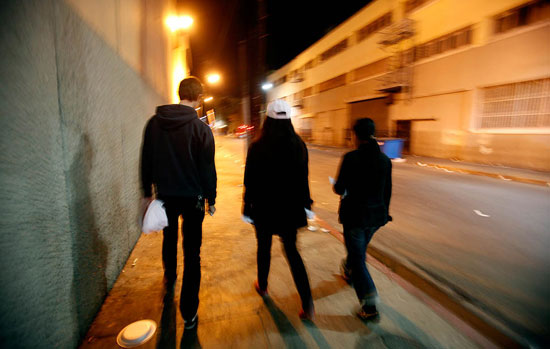
Homeless Count organizers are hoping for an even bigger volunteer turnout than in 2011. Photo/L.A. Times.
For Los Angeles to effectively confront the shame of homelessness, it needs a clear picture of the problem. And the 2013 Greater Los Angeles Homeless Count—the largest of its kind in the country—is preparing to undertake its most ambitious effort yet to bring the issue into sharper focus—hopefully, with your help.
“We have three thousand volunteers so far, and we’re trying to get to five thousand,” said Mark Silverbush, policy and planning analyst for the Los Angeles Homeless Services Authority, which organizes the count and coordinates regional efforts to assist the homeless. “We will have more data available than ever before.”
Silverbush said that more than 70 cities and 20 communities are joining the effort
Volunteers aged 18 and older can sign up online to participate in the count throughout L.A. County, except in the cities of Glendale, Pasadena and Long Beach, which are doing their own independent tallies. By car and by foot, teams of 3 or 4 counters will fan out to assigned areas to count homeless individuals, as well as tents and vehicles in which people appear to be sleeping. Friends can group together. The process takes about 4 to 5 hours, including the pre-count training.
Most counts take place at night when people are bedding down, which makes it easier to identify who is homeless, Silverbush said. Volunteers are instructed to keep a respectful distance and not engage the homeless population.
Homeless counts are required by the U.S. Department of Housing and Urban Development. The collected information is required to obtain federal monies to combat homelessness and is used to apply for other government funding.
“There are a lot of agencies and organizations and we all have anecdotes about the work we are doing, but it really helps to have these statistics,” Silverbush explained. “This is our once-in-every-two-years opportunity to refresh that data and make a difference in people’s lives.”
The count will take place during the course of three days. On Tuesday, January 29, volunteers will count in the San Gabriel Valley and East L.A. On Wednesday, January 30, they’ll head to West L.A. and the South Bay region. Finally, on Thursday, January 31, counters will canvass the Antelope Valley during the day and then, at night, move to the San Fernando Valley, Santa Clarita Valley, Downtown L.A. and South L.A.
This week, agencies that focus on youth homelessness undertook a countywide count of unaccompanied minors and transition-aged homeless youth between 18 and 24. Agency staffers recruited homeless and formerly homeless youths to help identify young people living on the streets. They also sought information about the population’s sexuality and how many came from foster care.
“The housing barriers that homeless youth face seem to be different,” Silverbush said. “We are looking at the research to figure out what the best interventions are. There are a lot of ideas out there, but not a lot of off-the-shelf ideas that we can really plug in and use.”
In February, advocates plan to undertake a separate survey of the adult population to collect further demographic data. They’ll use a matrix developed for the “housing first” program Project 50 to identify the most vulnerable homeless individuals, or those most likely to die on the streets.
Stan the Man and an L.A. boy
January 24, 2013
“I’d like to talk to Stan Musial.”
I was a baseball-crazed 11-year-old when I made that pronouncement to the telephone operator at the old Hotel Statler at Wilshire and Figueroa. I’d learned from a feature in the Sporting News that the St. Louis Cardinals were staying there during a series with the Dodgers—and I was determined to talk to Stan the Man, the visiting team’s star outfielder.
The nickname was spot-on. During a career spanning more than two decades, Musial would ultimately win seven batting titles, appear in 24 All-Star Games and set scores of records. He was that rare player who was elected to the Hall of Fame on the first ballot. Still, despite the gaudy numbers, he was also known as a humble gentleman, with little of the flash of such famous contemporaries as DiMaggio, Mantle and Mays. Musial spoke softly but carried a very big stick.
So I guess I shouldn’t have been surprised when he picked up the phone in his hotel room. But I was. He caught me off guard in my ruse as a radio sportscaster named Bob Price. (I didn’t think he’d bite on a name like Zev Yaroslavsky.) Trying my best to sound older than my pre-teen years, I asked a series of questions about the team’s strengths. He thoughtfully answered each, offering particular praise for a young right-handed pitcher named Bob Gibson, who’d one day join him in Cooperstown. Because I didn’t expect to actually talk to Musial, I quickly exhausted my list of questions.
I closed the “interview” by melodically saying, “Thank you, Stan Musial, for being on our sports show.” To which he said: “You’re welcome, son.” Turns out, he’d been playing along from the start, so free of self-importance that he was willing to take a few moments to give a kid a memory of a lifetime. Imagine that.
Last Saturday, at the age of 92, Stan Musial passed away, and that memory from the late 1950s came back to me with the power of one of his mighty swings. I know that, given the security concerns of today, such a phone conversation between a boy and a ballplayer would be highly unlikely. But I also wonder how many of our super-star athletes even recognize, as Musial did, the obligations that come with fame. Celebrity is not an entitlement. Forgive the cliché, but whether in sports or politics, you’ve got a responsibility to be a role model for those who look up to you.
Two years ago, this quality in Musial was recognized in a White House ceremony by President Obama, who presented him with the nation’s highest civilian award, the Medal of Freedom. Obama described Musial as “untarnished, a beloved pillar of the community, a gentleman you’d want your kids to emulate.” For my part, I’ve given it my best.
Sometimes, when I get a late-night call from a constituent with a problem—and they’re not play-acting—I think back to that day when Musial found time to talk to a young kid. And then I try to step up to the plate, too. Now 64, I’ll be forever grateful to the ballplayer who demonstrated what being a man is really about.
Posted 1/24/13
Board orders audit of sheriff’s budget
January 23, 2013

Sheriff patrols have been reduced throughout the county's unincorporated areas. Photo/Navymailman via Flickr
After a testy public confrontation with Los Angeles County Sheriff Lee Baca over patrol cutbacks, the Board of Supervisors unanimously called for a “forensic audit” of his department’s $2.8 billion budget.
The Tuesday action came after several supervisors accused the sheriff of potentially jeopardizing public safety by reducing the number of patrol cars in the county’s unincorporated areas to save money on rising overtime costs.
Baca insisted that, with crime rates down substantially, there was little danger that fewer patrol cars would lead to higher public risks. He said he had no choice after being hit with multimillion dollar budget cuts for three consecutive years and unacceptable overtime costs in recent weeks.
“We have the largest county in the United States, and the safest county in the United States,” Baca said, adding: “I just believe we need to account to [the public] as to what we’re doing and what are the true facts regarding their safety.”
Although the Board of Supervisors sets the department’s budget, the sheriff has wide discretion over how it’s actually spent.
During Tuesday’s Board hearing, Baca faced the stiffest criticism from Supervisor Gloria Molina, whose district includes the unincorporated community of East Los Angeles, among others.
“I’d like to cut your budget in other places and I’m going to try and find a way,” warned Molina, who joined with colleague Don Knabe in introducing the motion for an independent audit of the department’s budget.
Both Molina and Knabe suggested that Baca was undermining an “equity policy” ensuring that unincorporated areas get the same level of services as cities that contract with the department. Instead, Molina said, costs are being reduced in unincorporated areas to subsidize other department functions and responsibilities.
“You are stealing,” she told the sheriff, who responded: “Stealing is over the top, supervisor.”
“I want you to let me finish,” Molina interrupted.
“Not when you say something that is so outrageous that it’s not worth the dignity of your office,” the sheriff said.
Later, Molina apologized for the “stealing” characterization, and Baca thanked her for being a “stellar supporter” of the department. The sheriff also assured the board that he was already taking measures to ensure that patrol levels would not be reduced for long, including in the unincorporated area of Topanga Canyon in Supervisor Zev Yaroslavsky’s district. The vast majority of his district is patrolled by the Los Angeles Police Department.
No date was set for completion of the independent audit, which will be arranged through the county’s Auditor-Controller’s Office.
Posted 1/23/13
Westward ho for CicLAvia
January 17, 2013

Manifest destiny: CicLAvia's getting ready to roll all the way to the coast. Photo/planetc1 via Flickr
Saddle up, Westsiders: L.A.’s favorite rolling street party is headed your way in April.
CicLAvia, the car-free bicycle and pedestrian fest started in 2010, is on the move again, preparing for its most ambitious year yet with three events, including one that will stretch from downtown to Venice Beach on April 21.
It’s part of a major expansion that organizers hope eventually will stretch to all corners of the county and create 12 separate, localized CicLAvias each year.
“Up till now we’ve been downtown. Now we want to show that it will work in the rest of the region,” said Aaron Paley, CicLAvia’s co-founder. A second 2013 CicLAvia is being planned for June 23 with a new route expected to run along Wilshire Boulevard from downtown L.A. to Fairfax Avenue near LACMA. And this year’s third event, on October 6, will return to familiar territory downtown, although with a deeper stretch into Boyle Heights and a new route into Chinatown.
The downtown-to-Venice Beach route will be the longest yet for CicLAvia—15 ¼ miles each way—and carries with it some important cross-town symbolism.
“One of the things that’s exciting about connecting downtown and the Pacific is just the sheer drama and the significance of it,” Paley said. “We know that the east-west connection is very difficult and for people who drive it every day, it’s a challenge…The idea that you will be able to walk or ride your bike—or go in your wheelchair or do your inline skating—and go from downtown to the beach is just of historic significance.”
Venturing out on such a long ride should be attractive to many participants, but Paley said the event is more about creating a pop-up “linear park” on city streets than throwing down an endurance challenge.
“This isn’t the marathon. It isn’t all or nothing,” he said. “We want kids to be able to explore, maybe get out and ride in the streets for the first time that day. And if they ride a half mile, that’s great.”
The hope is that participants will arrive via public transportation if possible—perhaps by taking the Expo Line to the Culver City station at Venice and Robertson, or riding the bus to the Pico/Rimpau Transit Center at Venice and San Vicente.
Paley said the impetus for pushing outside the downtown zone and toward the ocean this year came from Los Angeles Mayor Antonio Villaraigosa, who kept asking: “When can we go all the way to the beach?”
The mayor, he said, even burst into a planning meeting to promote the idea—prompting a round of brainstorming in which the Department of Transportation’s special events traffic guru, Aram Sahakian, came up with the idea of using Venice Boulevard, a route traveled by other events like the Los Angeles triathlon.
“We’ve used it before. We know exactly what we’re dealing with,” Sahakian said.
Taking the route deep into the Westside—where traffic woes are among the city’s worst—will require plenty of outreach to make sure residents and businesses know what’s coming. “I’m crossing my fingers and praying that they won’t be too unhappy,” Sahakian said.
So far, so good, said Diana Rodgers, who manages the Mar Vista Farmers’ Market and is enthusiastic about the coming of CicLAvia to her area.
“We love it and we want to be a partner and provide refreshments,” she said.
The farmers’ market, which takes place on Sundays and is located on Venice at Grand View Boulevard, is accustomed to rolling with the closures that come with big events like the marathon and triathlon, Rodgers said, and should be able to take CicLAvia in stride.
“As long as we have the information, we tend to do OK, as long as we have crossing guards at the points needed,” Rodgers said.
Westside cyclists like Cynthia Rose, director of the group Santa Monica Spoke, said the new route will be a big draw in her part of town.
“There’s a huge pool of enthusiastic Westside supporters and they’ve felt sort of geographically separated,” she said. “Now all of a sudden it’s going to be that connecting of the dots, from the ocean to downtown Los Angeles.”
Paley said the final map for the downtown-to-Venice Beach route is still being fine-tuned. The CicLAvia team will be taking an exploratory ride along the proposed route Sunday to see how it works and connects with two major hubs downtown—City Hall and Union Station.
Beyond the 2013 lineup, he’s looking forward to CicLAvia’s gradual multi-year expansion.
“We want the entire county to be able to benefit from Ciclavia,” Paley said.
So what’s on tap for 2014? “I can tell you that the Valley,” Paley said, “is high on our list.”
Posted 1/17/13




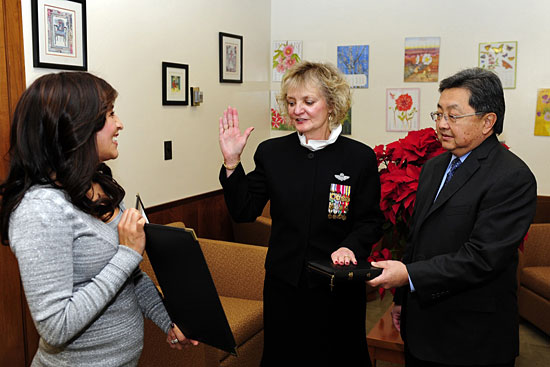
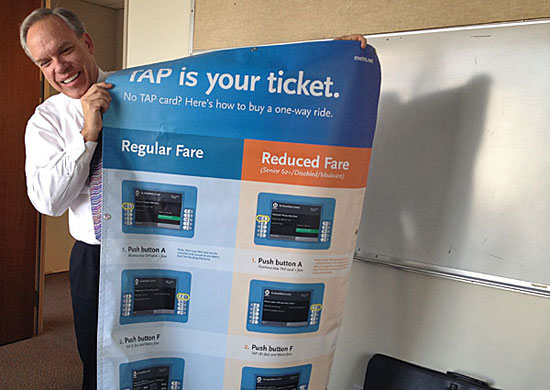
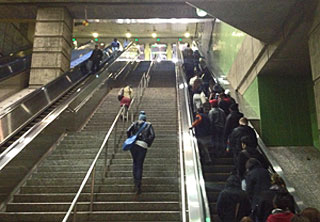









 Check for the latest closure information
Check for the latest closure information








